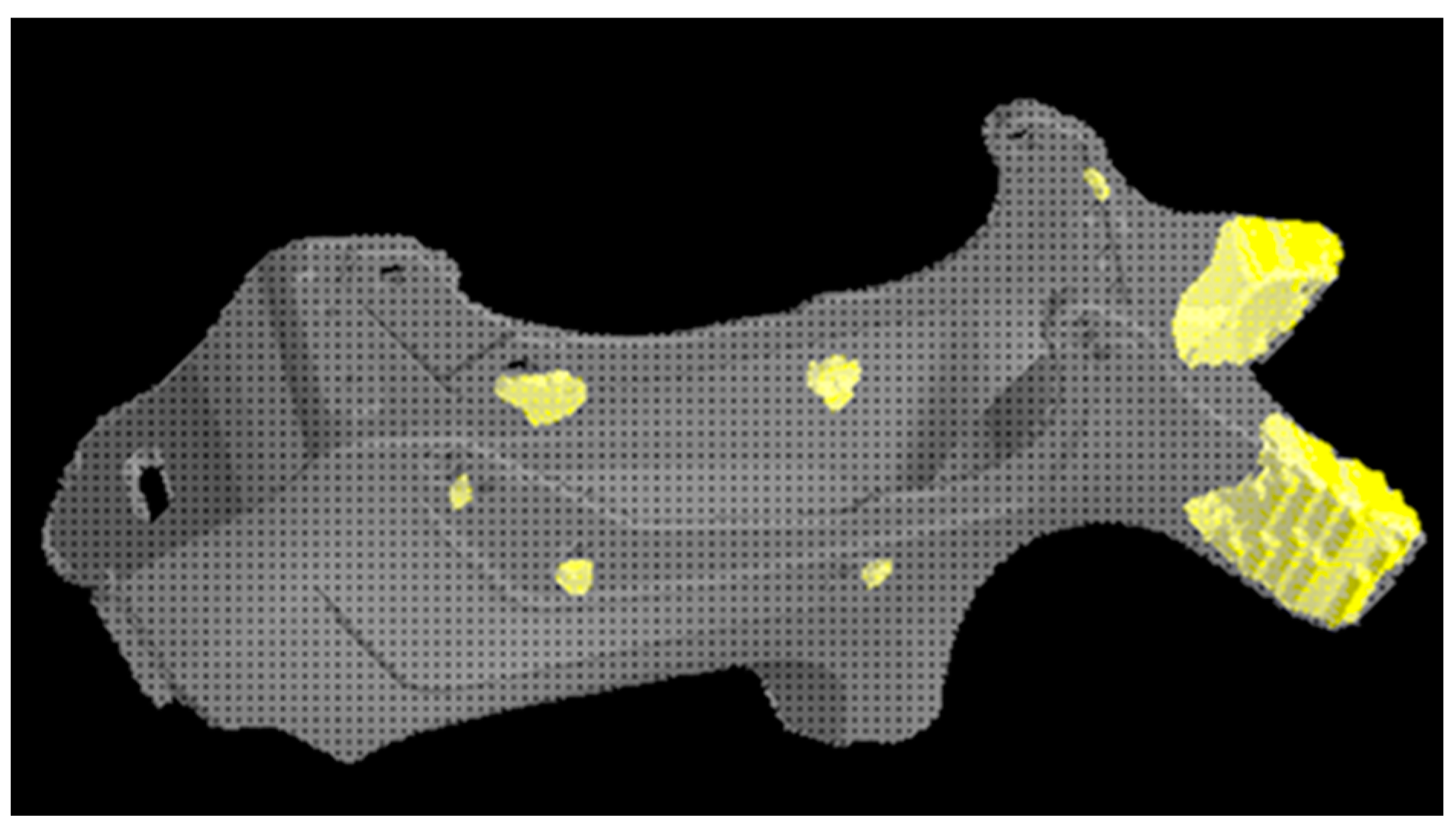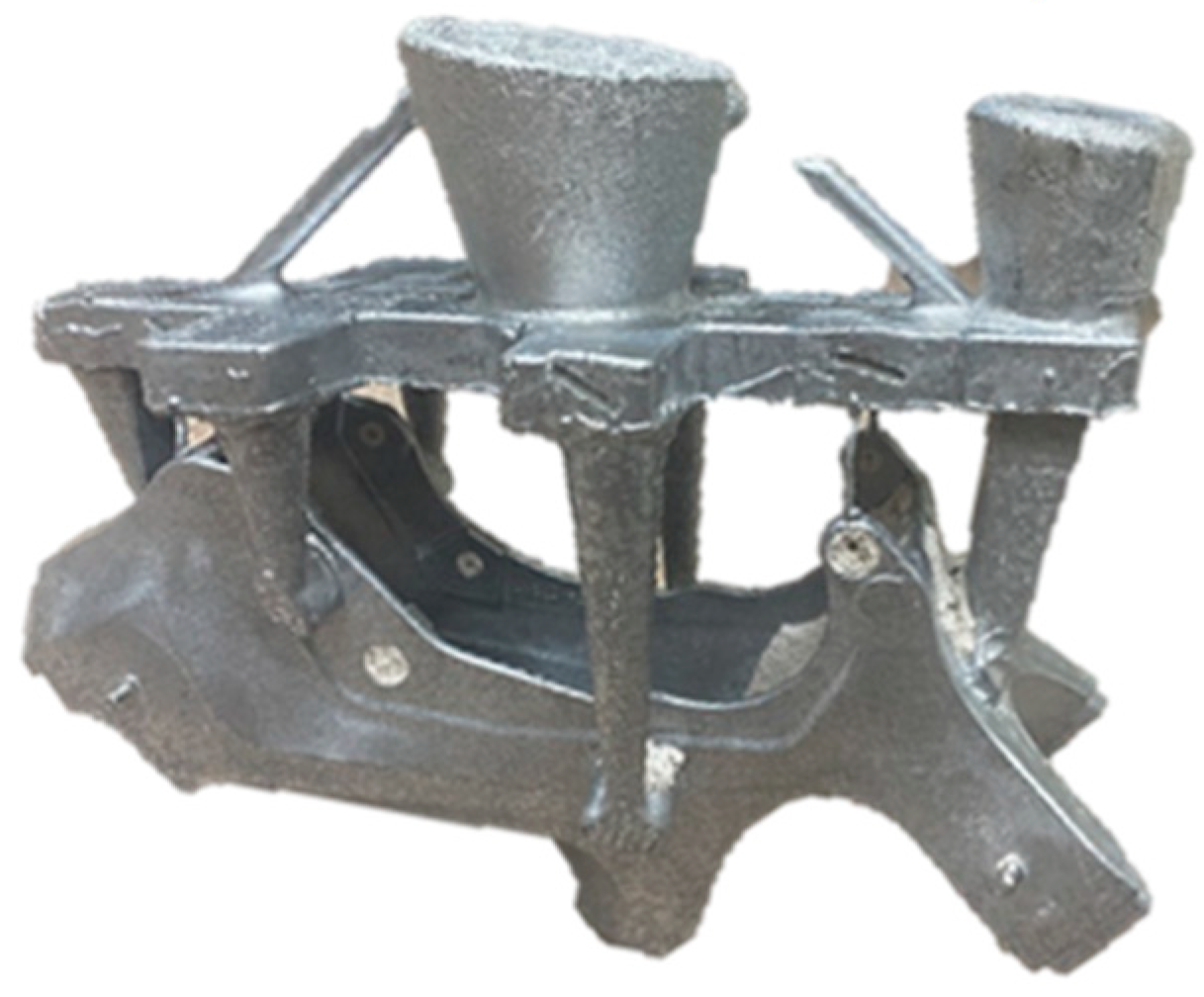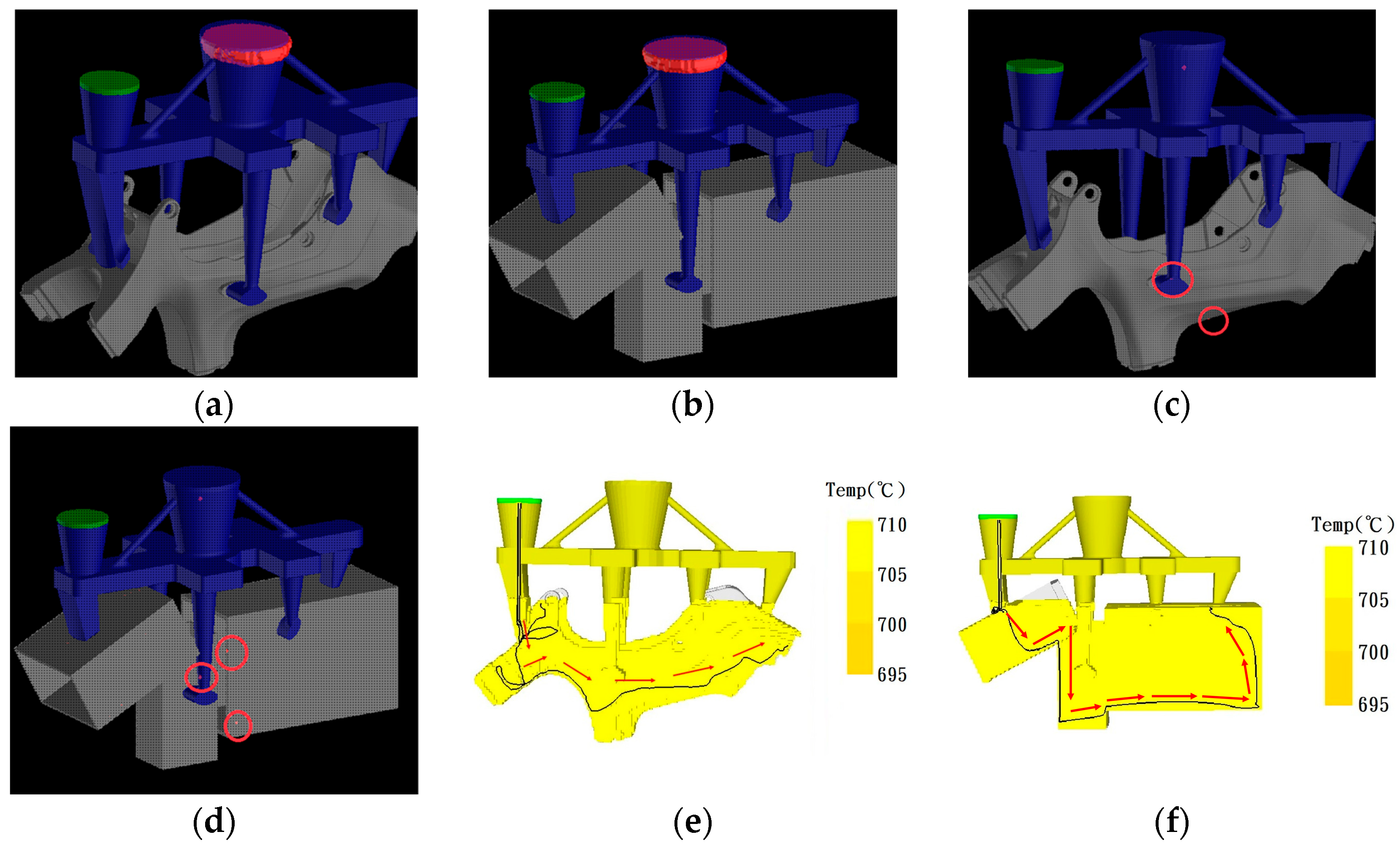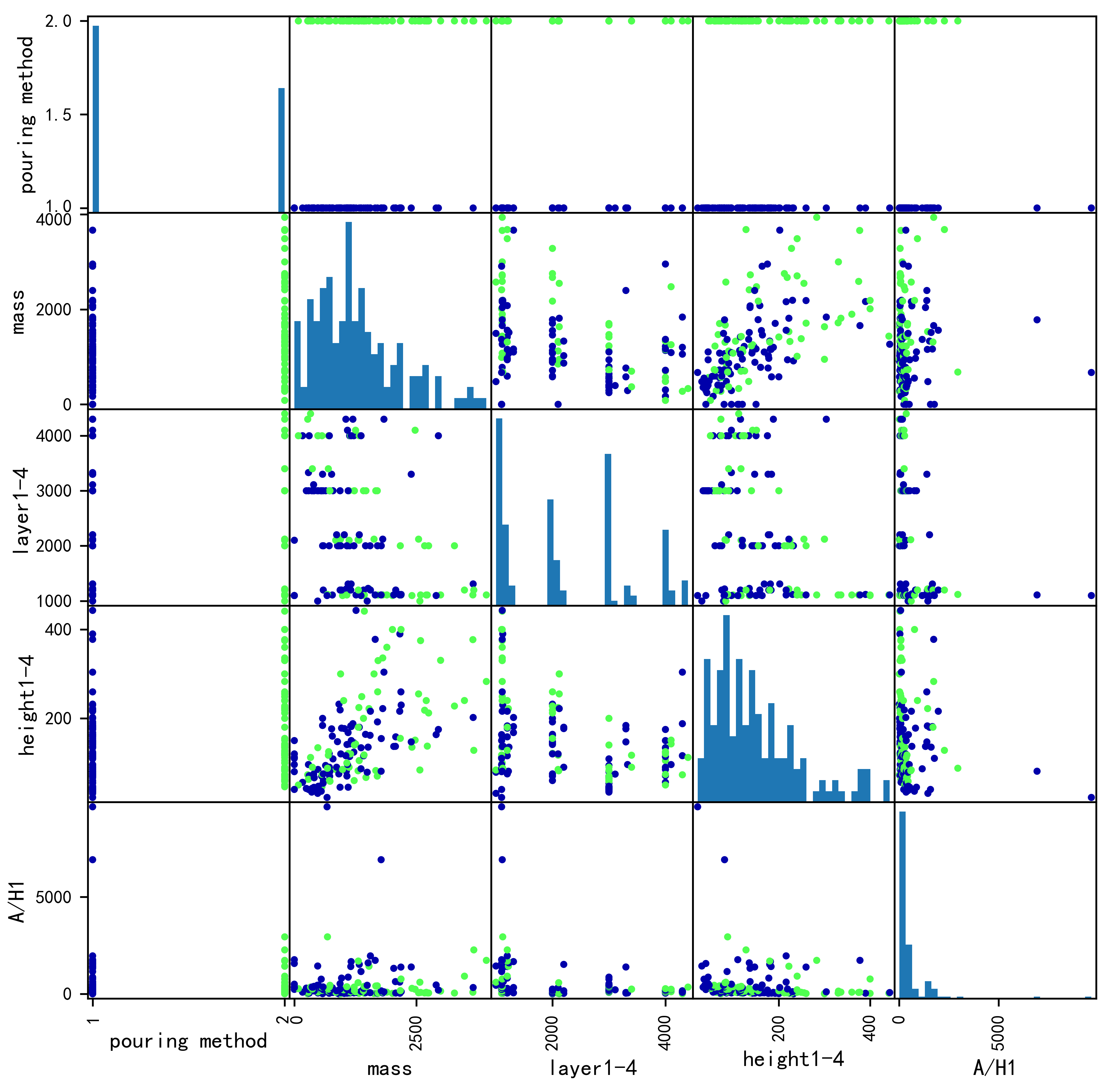Classification of 3D Casting Models for Product Lifecycle Management and Corporate Sustainability
Abstract
:1. Introduction
2. Research Method and Procedure
2.1. Model Dimensions
2.2. Model Pretreatment
2.3. Mold Flow Analysis
2.4. Specimen Preparation
3. Results and Discussion
3.1. Design Solution and Experimental Verification
3.2. Model Simplification and Comparison
3.3. Classification Type and Casting Method
3.4. Database and Learning
4. Conclusions
- Similar geometries can be applied to the same pouring system, but with the same range of volumes.
- Part simplification does result in data compression, as 150 castings ended up using only 37 methods, resulting in an average compression rate of 75% and preserving data integrity after compression.
- From a geometric analysis, it was found that the qualities of thin-shell rectangles, round tubes, and solid cylindrical castings were better when using side casting, and those of plate rectangles and pie models were better when using bottom casting. The quality of any shape of castings with a height from 55 mm to 200 mm was poor when using top casting.
- All of the model classification data in the database, including material and geometrical characteristics, can be directly used in machine learning for a predicted casting method with 88.8% accuracy. The data and the database constructed in this study are in line with digital product lifecycle management and successfully save costs for further development.
Author Contributions
Funding
Institutional Review Board Statement
Informed Consent Statement
Data Availability Statement
Acknowledgments
Conflicts of Interest
Appendix A
- A: Cylinder; A1: Solid Cylinder; A2: Hollow Cylinder
- B: Rectangle; B1: Solid Rectangle; B2: Shell Rectangle
- D: No Geometry
- X0, Y0, Z0: Coordinate Datum
- : Distance in the X Direction from the Coordinate Datum
- : Distance in the Y Direction from the Coordinate Datum
- : Distance in the Z Direction from the Coordinate Datum
- SEM: Scanning Electron Microscope
- EDX: Energy-dispersive X-ray Spectroscopy
- Δ: Difference in Temperature or Pressure
Appendix B
References
- Terzi, S.; Bouras, A.; Dutta, D.; Garetti, M.; Kiritsis, D. Product Lifecycle Management—From Its History to Its New Role. J. Prod. Lifecycle Manag. 2010, 4, 360–389. [Google Scholar] [CrossRef]
- Wijayasekera, S.C.; Hewage, K.; Hettiaratchi, P.; Siddiqui, Q.; Razi, F.; Pokhrel, D.; Sadiq, R. Sustainability of Waste-to-hydrogen Conversion Pathways: A Life Cycle Thinking-based Assessment. Energy Convers. Manag. 2022, 270, 116218. [Google Scholar] [CrossRef]
- Chen, Y.; Xu, Z.; Wang, J.; Lund, P.D.; Han, Y.; Cheng, T. Multi-objective Optimization of An Integrated Energy System Against Energy, Supply-demand Matching and Exergo-environmental Cost Over the Whole Life-cycle. Energy Convers. Manag. 2022, 254, 115203. [Google Scholar] [CrossRef]
- Sohns, T.M.; Aysolmaz, B.; Figge, L.; Joshi, A. Green Business Process Management for Business Sustainability: A Case Study of Manufacturing Small and Medium-sized Enterprises (SMEs) from Germany. J. Clean. Prod. 2023, 401, 136667. [Google Scholar] [CrossRef]
- Ferreira, J.J.; Lopes, J.M.; Gomes, S.; Rammal, H.G. Industry 4.0 Implementation: Environmental and Social Sustainability in Manufacturing Multinational Enterprises. J. Clean. Prod. 2023, 404, 136841. [Google Scholar] [CrossRef]
- Mory-Alvarado, A.; Juiz, C.; Bermejo, B.; Campoverde-Molina, M. Green IT in Small and Medium-sized Enterprises: A Systematic Literature Review. Sustain. Comput. Inform. Syst. 2023, 39, 100891. [Google Scholar] [CrossRef]
- Favi, C.; Campi, F.; Germani, M.; Mandolini, M. Engineering Knowledge Formalization and Proposition for Informatics Development Towards a CAD-integrated DfX System for Product Design. Adv. Eng. Inform. 2022, 51, 101537. [Google Scholar] [CrossRef]
- Hong, T.; Lee, K.; Kim, S. Similarity Comparison of Mechanical Parts to Reuse Existing Designs. Comput. Aided Des. 2006, 38, 973–984. [Google Scholar] [CrossRef]
- Dou, K.; Lordan, E.; Zhang, Y.J.; Jacot, A.; Fan, Z.Y. A Complete Computer Aided Engineering (CAE) Modelling and Optimization of High Pressure Die Casting (HPDC) Process. J. Manuf. Process. 2020, 60, 435–446. [Google Scholar] [CrossRef]
- Xu, Q.; Zhong, M.; Li, X. How does Digitalization Affect Energy? International Evidence. Energy Econ. 2022, 107, 105879. [Google Scholar] [CrossRef]
- Pradhan, A.R.; Pattnaik, S.; Sutar, M.K. Improving the Filling System for a Defect Free Casting: A Review. Mater. Today Proc. 2019, 18, 2887–2892. [Google Scholar] [CrossRef]
- Dong, Y.W.; Li, X.L.; Zhao, Q.; Yang, J.; Dao, M. Modeling of Shrinkage During Investment Casting of Thin-walled Hollow Turbine Blades. J. Mater. Process. Technol. 2017, 244, 190–203. [Google Scholar] [CrossRef]
- Patnaik, L.; Saravanan, I.; Kumar, S. Die Casting Parameters and Simulations for Crankcase of Automobile Using MAGMAsoft. Mater. Today Proc. 2020, 22, 563–571. [Google Scholar] [CrossRef]
- Lee, H.; Lee, J.; Kwon, S.; Ramani, K.; Chi, H.; Mun, D. Simplification of 3D CAD Model in Voxel Form for Mechanical Parts Using Generative Adversarial Networks. Comput. Aided Des. 2023, 163, 103577. [Google Scholar] [CrossRef]
- Kwon, S.; Mun, D.; Kim, B.C.; Han, S.; Suh, H.W. B-rep Model Simplification Using Selective and Iterative Volume Decomposition to Obtain Finer Multi-resolution Models. Comput. Aided Des. 2019, 112, 23–34. [Google Scholar] [CrossRef]
- Bahoo, Y.; Durocher, S.; Keil, J.M.; Mondal, D.; Mehrabi, S.; Mehrpour, S. Polygon Simplification by Minimizing Convex Corners. Theor. Comput. Sci. 2019, 791, 76–86. [Google Scholar] [CrossRef]
- Da, D.; Xia, L.; Li, G.; Huang, X. Evolutionary Topology Optimization of Continuum Structures with Smooth Boundary Representation. Struct. Multidisc. Optim. 2018, 57, 2143–2159. [Google Scholar] [CrossRef]
- Zhang, H.; Zhang, S.; Zhang, Y.; Liang, J.; Wang, Z. Machining Feature Recognition Based on a Novel Multi-task Deep Learning Network. Robot. Comput.-Integr. Manuf. 2022, 77, 102369. [Google Scholar] [CrossRef]
- Li, C.; Wei, P.; Luo, X.; Jiang, Z.; Wang, D. An unified CAD/CAE/VR Tool for Ship Structure Design and Evaluation Based on Multi-domain Feature Mapping. Ocean Eng. 2023, 280, 114888. [Google Scholar] [CrossRef]
- Klees, M.; Evirgen, S. Building a Smart Database for Predictive Maintenance in Already Implemented Manufacturing Systems. Procedia Comput. Sci. 2022, 204, 14–21. [Google Scholar] [CrossRef]
- Bickel, S.; Sauer, C.; Schleich, B.; Wartzack, S. Comparing CAD Part Models for Geometrical Similarity: A Concept Using Machine Learning Algorithms. Procedia CIRP 2021, 96, 133–138. [Google Scholar] [CrossRef]
- Besharati-Foumani, H.; Lohtander, M.; Varis, J. Fundamentals and New Achievements in Feature-based Modeling, A Review. Procedia Manuf. 2020, 51, 998–1004. [Google Scholar] [CrossRef]
- Ji, B.; Zhang, J.; Li, Y.; Pang, J. Free-form CAD Model Retrieval Approach for Engineering Reuse Based on Local Feature Segmentation. Comput. Graph. 2023, 111, 111–121. [Google Scholar] [CrossRef]
- Bickel, S.; Schleich, B.; Wartzack, S. A Novel Shape Retrieval Method for 3D Mechanical Components Based on Object Projection, Pre-trained Deep Learning Models and Autoencoder. Comput. Aided Des. 2023, 154, 103417. [Google Scholar] [CrossRef]
- Yang, Y.; Hinduja, S.; Owodunni, O.O.; Heinemann, R. Recognition of Features in Sheet Metal Parts Manufactured Using Progressive Dies. Comput. Aided Des. 2021, 134, 102991. [Google Scholar] [CrossRef]
- Yepez, P.; Alsayyed, B.; Ahmad, R. Automated Maintenance Plan Generation Based on CAD Model Feature Recognition. Procedia CIRP 2018, 70, 35–40. [Google Scholar] [CrossRef]
- Favi, C.; Mandolini, M.; Campi, F.; Germani, M. A CAD-based Design for Manufacturing Method for Casted Components. Procedia CIRP. 2021, 100, 235–240. [Google Scholar] [CrossRef]
- Ren, S.; Zhang, Y.; Liu, Y.; Sakao, T.; Huisingh, D.; Almeida, C.M.V.B. A Comprehensive Review of Big Data Analytics Throughout Product Lifecycle to Support Sustainable Smart Manufacturing: A Framework, Challenges and Future Research Directions. J. Clean. Prod. 2019, 210, 1343–1365. [Google Scholar] [CrossRef]











| Shape | Rectangle | Cylinder |
|---|---|---|
| Length (mm) | 100~250 | - |
| Width (mm) | 100~250 | - |
| Height (mm) | 55~200 | 10~400 |
| Diameter (mm) | - | Below 250 |
| A1 | A2 | B1 | B2 |
|---|---|---|---|
 |  |  |  |
 |  |
| A/A/A | A/A/D | A/D/D | B/B/D | B/D/D |
|---|---|---|---|---|
 |  |  |  |  |
 |
| Temperature | Shell Mold | Casting Time | Temperature Difference | Flow Rate Difference | Pressure Drop | Simulation Mesh |
|---|---|---|---|---|---|---|
| 710 °C | 6 mm | 20 s | ≤100 °C | ≤1.5 m/s | ≤5 kPa | 1.5 mm |
| Element | Si | Fe | Cu | Mn | Mg | Ti | Zn | Al |
|---|---|---|---|---|---|---|---|---|
| Wt% | 6.5–7.5 | ≤0.15 | ≤0.2 | ≤0.1 | 0.25–0.45 | ≤0.2 | ≤0.1 | Bal. |
| Side Casting | Bottom Casting | |||
|---|---|---|---|---|
 |  |  |  |  |
| Category 1 | Category 3 | Category 5 | Category 2 | Category 4 |
| Δ20.8 °C | Δ48.5 °C | Δ27.7 °C | Δ27.7 °C | Δ20.8 °C |
| Δ116.4 Pa | Δ2488 Pa | Δ592 Pa | Δ983.4 Pa | Δ36.4 Pa |
| Category 1 | Category 2 | Category 3 | Category 4 | Category 5 |
|---|---|---|---|---|
| 76.7% (7/30) | 73.4% (8/30) | 83.4% (5/30) | 63.4% (11/30) | 80% (6/30) |
| A2/A1 A1/A1 A2/A1/A2 A1/A1/A1 A1/A1/A1/A1 A1/A1/A1/A2 A1/A1/A1/A1/A1 | A1 A2/A2 A2/A1 A1/A1 A1/A2 A1/A1/A2 A1/A2/A1 A2/A1/A1 | A2 A1/A2 A2/B1 A2/B1/B1 A1/A2/A2 | B1 B1/B1 B1/B1/B1 B1/B1/B1/B1 B1/B1/B1/B1/B1 B1/B1/B1/B1/B1/B1 B1/A2 B1/A1 B1/A1/A1 B1/A1/A1 B1/B1/A1/A1/A1/A1 | B2 B2/B1 B1/B1 B1/B2 B2/A1 B2/B2 |
Disclaimer/Publisher’s Note: The statements, opinions and data contained in all publications are solely those of the individual author(s) and contributor(s) and not of MDPI and/or the editor(s). MDPI and/or the editor(s) disclaim responsibility for any injury to people or property resulting from any ideas, methods, instructions or products referred to in the content. |
© 2023 by the authors. Licensee MDPI, Basel, Switzerland. This article is an open access article distributed under the terms and conditions of the Creative Commons Attribution (CC BY) license (https://creativecommons.org/licenses/by/4.0/).
Share and Cite
Chen, T.-M.; Wu, J.-Q.; Lin, J.-T. Classification of 3D Casting Models for Product Lifecycle Management and Corporate Sustainability. Sustainability 2023, 15, 12683. https://doi.org/10.3390/su151712683
Chen T-M, Wu J-Q, Lin J-T. Classification of 3D Casting Models for Product Lifecycle Management and Corporate Sustainability. Sustainability. 2023; 15(17):12683. https://doi.org/10.3390/su151712683
Chicago/Turabian StyleChen, Tzung-Ming, Jia-Qi Wu, and Jian-Ting Lin. 2023. "Classification of 3D Casting Models for Product Lifecycle Management and Corporate Sustainability" Sustainability 15, no. 17: 12683. https://doi.org/10.3390/su151712683
APA StyleChen, T.-M., Wu, J.-Q., & Lin, J.-T. (2023). Classification of 3D Casting Models for Product Lifecycle Management and Corporate Sustainability. Sustainability, 15(17), 12683. https://doi.org/10.3390/su151712683






